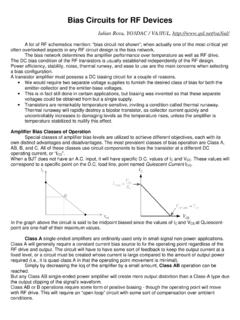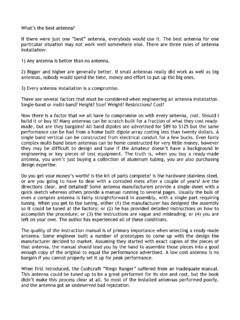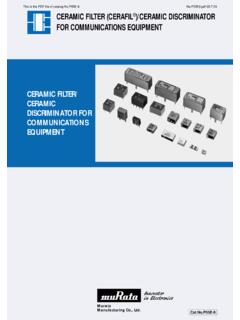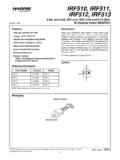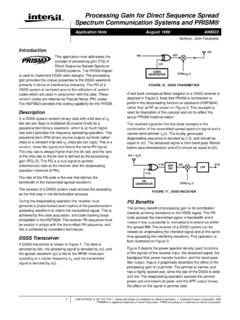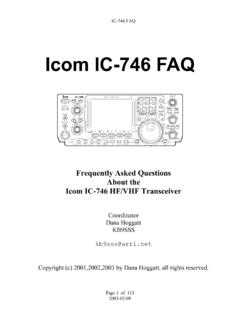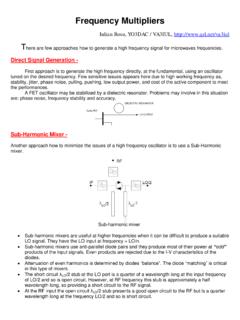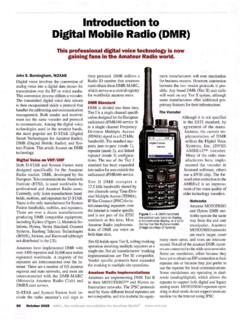Transcription of Impedance Matching - QSL.net
1 Impedance Matching Iulian Rosu, YO3 DAC / VA3 IUL, The term Impedance is a general term which can be applied to any electrical ethnicity which impedes (obstruct) the flow of the current. Oliver Heaviside (1850-1925) coined Impedance definition, as well as many other terms of art in electromagnetic theory: Inductance, Admittance, Conductance, Permeability, Permittance (Susceptance), Reluctance, Electret. Oliver Heaviside also reformulated Maxwell's field equations in terms of electric and magnetic forces and energy flux, and independently co-formulated Vector Analysis, which is needed to express the Impedance in coordinates. Impedance Matching was originally developed for electrical power, but can be applied to any other field where a form of energy (not necessarily electrical) is transferred between a source and a load.
2 The first Impedance Matching concept in RF domain was related to Antenna Matching . Designing an antenna can be seen as Matching the free space to a transmitter or a receiver. Impedance Matching is always performed between two specified terminations The main purpose of Impedance Matching is to match two different terminations (Rsource and RLoad) through a specific pass-band, without having control over stop-band frequencies. We may assume that component losses are negligible but parasitic effects need to be considered. Reactance and LC Resonance Reactance X is a measure of the opposition to the current of Capacitance C and Inductance L. Reactance is measured in ohms and varies with the frequency of the AC signal. Reactance takes two forms: Inductive (XL), and Capacitive (XC).
3 XL = L = 2 f L XC = 1 / ( C) = 1 / (2 f C) Where: is angular frequency, f is frequency, L is inductance, and C is capacitance. When the magnitudes of L reactance and C reactance are equal, the L-C pair resonates. At resonance the net reactance of a series-connected L-C circuit is zero (a short circuit), and the net reactance of a parallel-connected L-C circuit is infinite (an open circuit). The resonant frequency is getting by equating the magnitudes of the L and C reactances (XL = XC) Quality-Factor The Quality Factor Q serves as a measure of a reactance s purity (how close it is to being a pure reactance, and not a resistance), and is defined as the ratio of the energy stored in a component to the energy dissipated by the component.
4 Q is a dimensionless unit and is expressed function of reactance X and resistance R as: Q = X / R It should be stated that Q of the L-C circuit is defined at circuit resonance. If the circuit reactance is plotted as a function of frequency, the slope of the reactance at resonance is a measure of Q. Resonant frequency is given by: The Quality Factor Q of a reactive component (inductor or a capacitor) is the ratio of its reactance magnitude to its resistance. Q of an inductor: Q of a capacitor: Unloaded-Q The loaded quality factor QL is the ratio of the magnitude of the reactance of either L or C at resonance, to the total circuit resistance. In real physical reactive elements there are always some resistive losses.
5 The loss in a component (a capacitor or an inductor) can be described in terms of its Q. For example, if a lossy inductor is placed in parallel with a lossless capacitor, the Q of the resulting parallel circuit is almost equal to the Q of the inductor. The unloaded-Q (QU) is the Q associated with the reactive elements only ( , without the load). Loaded-Q The loaded Q of a resonant circuit is dependent upon three main factors: 1. The source resistance (Rs). 2. The load resistance (RL). 3. The component Q-factor as defined above. The resonant circuit sees an equivalent RP resistance, RS in parallel with RL, as the load. The RP resistance is smaller in value than either RS or RL RP = (RS x RL) / (RS + RL) To optimize the loaded-Q there are two options.
6 First, we can select the optimum values for source and load impedances, or second, we can use different ratio values for L and C. Decreasing the RP will decrease the Q of the resonant circuit, and an increase in RP will increase the Q of the circuit. Can get the same effect if we keep RP constant and varying XP. Example: Using a parallel L-C circuit, at the same resonant frequency (178 MHz), we get different Q values just changing the L and C values, when keeping RP constant (50 ). - If RP = 50 , C = 8pF, L = 100nH, at 178 MHz we get: XP = XC = XL = , results Q = - If RP = 50 , C = 400pF, L = 2nH, at 178 MHz we get: XP = XC = XL = , results Q = Impedance Impedance is an important parameter to characterize electronic circuits, components, and materials used to make components.
7 Impedance Z is defined as the total opposition of a device or circuit to the flow of an alternating current (AC) at a given frequency, and is represented as a complex quantity which is graphically shown on a vector plane. RP = equivalent parallel resistance of RS and RL XP = inductive or capacitive reactance (both equal at resonant frequency) Assuming lossless components: An Impedance vector consists of a real part (resistance, R) and an imaginary part (reactance, X). Impedance can be expressed using the rectangular-coordinate form: Z = R + jX or in the polar form as a magnitude and phase angle: Z = |Z| Impedance varies with frequency, when the effect of resistance is constant regardless of frequency. Maximum Power Transfer Designing circuits involves the efficient transfer of the signals.
8 In the early days of electric motors, it was found that to get the most efficient transfer of power from the battery (source) into the motor (load) required that the resistance of the different parts of the circuit be the same, in other words, matched; this is known as the maximum power transfer theorem. For DC circuits, maximum power will be transferred from a source to its load if the load resistance equals the source resistance. A simple proof of this theorem is given by the following example: The circuit and graph to prove the condition for maximum power transfer (vs and vout refer to value) With the equation above we can calculate and plot the power delivered to the load for various load resistances.
9 When the load is zero, no power can be delivered to it, and as the resistance RL increases above zero, the voltage across it and dissipated power increases. As the RL further increases, the value of POUT reaches a peak (where RL = Rs) and thereafter decreases. Impedance Matching The main role in any Impedance Matching scheme is to force a load Impedance to look like the complex conjugate of the source Impedance , and maximum power can be transferred to the load. When a source termination is matched to a load with passive lossless two-port network, the source is conjugated matched to the input of the network, and also the load is conjugate matched to the output of the network. Any reactance between Rs and RL reduces the current in RL and with it the power dissipated in RL.
10 To restore the dissipation to the maximum that occurs when Rs = RL, the net reactance of the loop must be zero. This occurs when the load and source are made to be complex conjugates one of another, so they have the same real parts and opposite type reactive parts. If the source Impedance is Zs = R + jX, then its complex conjugate would be Zs* = R jX. Impedance Matching of a resistive source and a complex load for maximum power transfer Using only one series reactive element between two equal resistive terminations creates a voltage drop that reduces the voltage across the load. Impedance Matching can eliminate or minimize the unwanted reactance through a range of frequencies. The Matching process becomes more difficult when real parts of the terminations are unequal, or when they have complex impedances.
